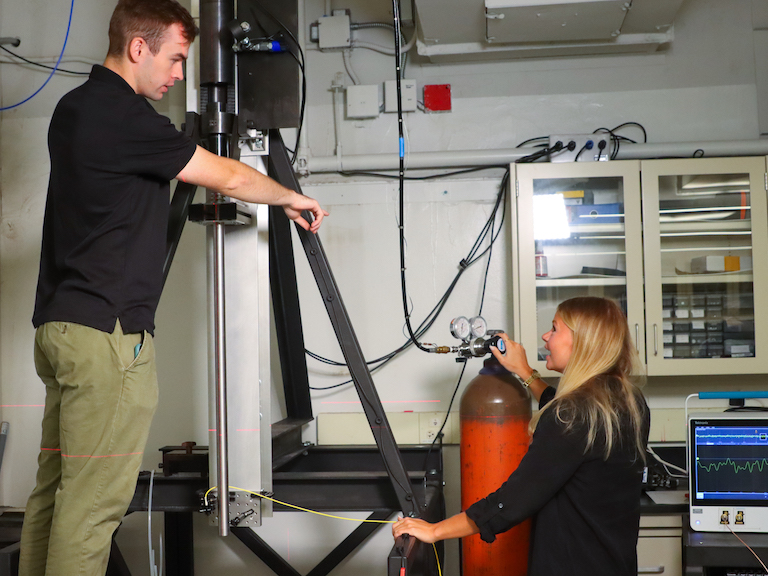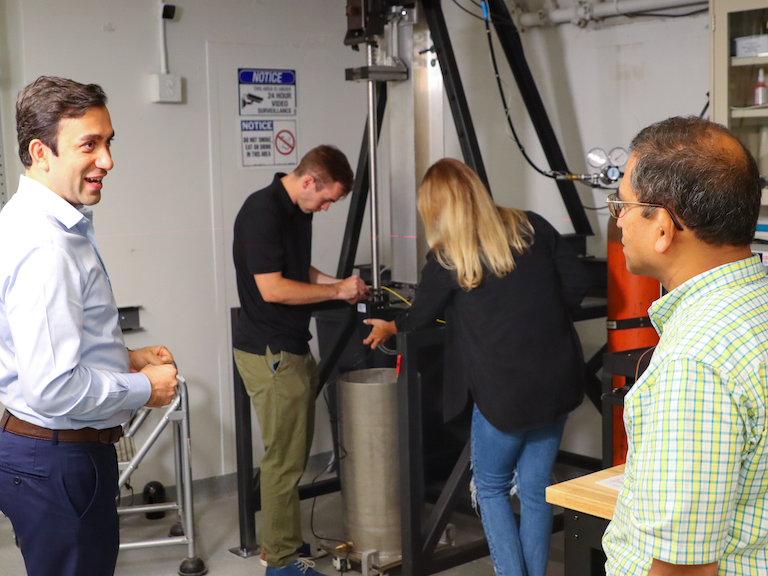Engineers Working on Department of Defense Project to Analyze Former Test Sites
Civil engineers are helping the U.S. military maintain a safe environment.
 Manhattan College civil engineering students are helping the United States Department of Defense be environmentally sound and more cost-efficient, thanks to a $560,000 grant from the Strategic Environmental Research and Development Program (SERDP) with the Department of Defense.
Manhattan College civil engineering students are helping the United States Department of Defense be environmentally sound and more cost-efficient, thanks to a $560,000 grant from the Strategic Environmental Research and Development Program (SERDP) with the Department of Defense.
In 2019, Mehdi Omidvar, Ph.D., associate professor of civil engineering, in collaboration with colleagues at New York University and the Southwest Research Institute, received $1.8 million in federal funding to predict the location of buried weapons at formerly used defense sites, in an effort that could save the federal government millions of dollars and turn old military testing grounds into residential and commercial recreation sites.
A handful of current Manhattan College students and recent graduates have worked on the project during the past three years, including Dylan Grace ’20, ’21 (M.S.), Brian Kenneally ’21 (M.S.) Rachel White ’20, ’21 (M.S.), and Rachel Foertch ’21.
Geotechnical and Environmental Work Ongoing
The U.S. military has identified more than 10,000 formerly used defense sites across the country that were used for weapons practice. SERDP is working with the Manhattan College group, and others, to create a method to predict where there are any unexpected ordinances, or already used munitions, in the ground.
“In application, this is a problem that has both geotechnical and environmental aspects,” said Kenneally, who earned his undergraduate degree in physics at the University of Richmond before pursuing a master’s degree in environmental engineering at Manhattan.
“[The work] is going to be used for environmental remediation projects at these sites,” Kenneally explained. “When there are these different unexploded ordnances in the ground, they pose a serious risk of explosion. There are also chemicals that can find their way into drinking water. In addition to the need to save taxpayer dollars and get the land to be usable for private use, there’s a serious environmental application to this.”
The group is working on a multi-faceted approach to predicting the depth of burial of these unexploded ordnances in the ground. They have put together state-of-the-art ballistic testing facilities at Manhattan College, and use laser light to track projectile motion in a variety of soil targets.
A Mix of Math and Physics
These experiments are then used to develop mathematical models to predict the depth of burial of different munitions in the ground. The group is also developing advanced numerical simulations that further advance their understanding of the problem.
“This project involves a lot of applied physics,” Omidvar said. “We are in a unique position to run experiments and gain an in-depth understanding of this complex problem. We then take these observations and translate them into mathematical relationships. Our students are able to apply what they have learned in class to a very challenging problem that has important real-world applications.”
 “It brings out the aspects of the engineering education that are the focus of our programs,” Omidvar continued. “Working on this project has empowered our students to elevate their capabilities. At the same time, the interdisciplinary nature of this work has allowed them to apply their engineering knowledge to problems beyond what is taught in the classroom.”
“It brings out the aspects of the engineering education that are the focus of our programs,” Omidvar continued. “Working on this project has empowered our students to elevate their capabilities. At the same time, the interdisciplinary nature of this work has allowed them to apply their engineering knowledge to problems beyond what is taught in the classroom.”
Grace has been heavily involved in the experimental campaign, where he uses a projectile launcher and a photon Doppler velocimeter to measure projectile velocities in soil targets.
“We’re able to approach this problem from the ground up, and build something and operate it and make it work,” Grace said. “It’s rewarding to see all of the complex components of the project come together after months of planning and design. We are now analyzing the data from our experiments, and are gaining a deeper understanding of the problem. We then have to explain what we’re doing and describe the results to our collaborators.”
Computer Simulations Prove Vital
An important part of the group’s work is creating a set of computer simulations. The Manhattan team is producing its own data and training its systems to simulate different scenarios. That is where White comes in.
“I never expected myself to know this much about computers or simulating in general,” White said. “I’ve had a lot of opportunities to challenge myself and find out what I’ve been capable of.”
White has created computer advanced simulations that accurately predict the experiments that Grace is carrying out. White also collaborates with NYU researchers who provide the soil properties needed for the mathematical models in her simulations.
“I have gained valuable skills working on this project, such as collaborating with other researchers, and presenting our results in technical documents and publications. I have also had the opportunity to mentor other undergraduate students on the project,” White said.
By the end of 2022, the group will submit their mathematical models to the Department of Defense for predicting results of full-scale live-fire tests. The tools developed by the research team then will be used in remediation of formerly used defense sites across the country.